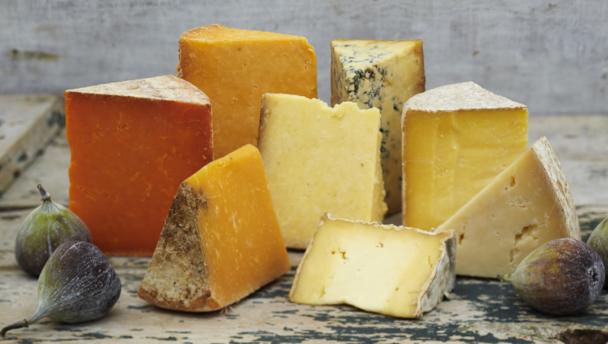

Cheese is a dairy product made from cream, curdled or skimmed milk, or a mixture of these. It can range from mild, fresh soft cheeses such as cream cheese, to pungently flavoured, mature blue cheeses such as Stilton, or aged hard cheeses such as Parmesan, which are very dry in texture. Made around the world from cow, sheep, water buffalo, goat and even reindeer milk, cheese is sold pasteurised or raw, plain or flavoured, pickled, processed or even, occasionally, sweet.
 Easy chicken and pea risotto
Easy chicken and pea risotto
 'Nduja sausage and sheeps’ cheese pizza
'Nduja sausage and sheeps’ cheese pizza
 Roast squash and sweet potato soup with buttermilk blue cheese sauce
Roast squash and sweet potato soup with buttermilk blue cheese sauce
 Spinach and cheese samosas
Spinach and cheese samosas
 Baked eggs
Baked eggs
 Cucumber and feta bites with dill and pomegranate
Cucumber and feta bites with dill and pomegranate
 Cheese nuggets with grape chutney and pecan salad
Cheese nuggets with grape chutney and pecan salad
 Sugar-free spiced carrot cake with orange cream cheese frosting
Sugar-free spiced carrot cake with orange cream cheese frosting
 Cheese scone
Cheese scone
 Delia's any kind of cheese sauce
Delia's any kind of cheese sauce
 Onion marmalade
Onion marmalade
Most cheeses are available all year round, but a few traditionally-made cheeses, such as Gruyère and Vacherin Mont d’Or, have a season when they are considered to be at their best.
If possible, it’s best to buy cheeses from a specialist who stores their stock well and will be able to suggest which cheese will be best for your purpose. Specialist suppliers will also allow you to taste a range of cheeses before purchase.
Ideally, cheeses should be stored in a cool place such as a larder, cellar or garage at about 8–15C/46-59F, although they can also be kept in the salad drawer of the fridge, well-wrapped to prevent them from drying out. Cling film is not an ideal wrapping for cheese, as moisture can build up underneath it and encourage mould growth. Waxed paper is much better, but aluminium foil can also be used, particularly for blue cheeses. Some soft cheeses, such as Brie, may benefit from being left for a few days before eating: ask your cheesemonger for advice as to their ripeness, or wait until a couple of days before the use-by date to eat them. Cheese should be brought to room temperature (removed from the fridge) an hour or two before serving. Most cheeses can be frozen without adverse effects to their flavour, but hard cheeses may become crumbly on defrosting.
As well as being popular on its own, particularly when served with biscuits and fruit at the end of a meal, cheese is a common ingredient in cookery, whether as a last-minute garnish, or melted into sauces, soufflés or other hot dishes.
Vegetarians should bear in mind that many cheeses are made using animal rennet: always check the label if this is a concern. Pregnant women, and those with compromised immune systems, should avoid many soft-rinded cheeses, such as Brie, blue cheeses and those made from unpasteurised milk.
It is worth remembering that some cheeses are as much as 75% fat and can also have a high salt content. However, cheese is highly nutritious, as it retains nearly all the fat and fat-soluble vitamins from the milk, as well as much of its protein and many of the minerals.
Article by Felicity Cloake
Type the ingredients you want to use, then click Go. For better results you can use quotation marks around phrases (e.g. "chicken breast"). Alternatively you can search by chef, programme, cuisine, diet, or dish (e.g. Lasagne).